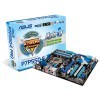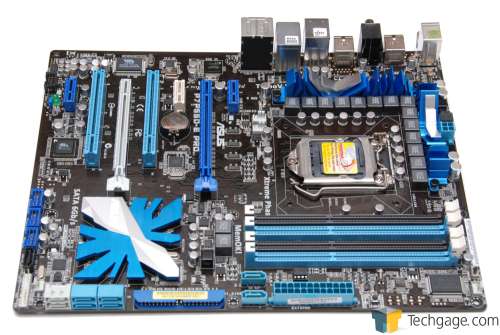- Qualcomm Launches Snapdragon 4 Gen 2 Mobile Platform
- AMD Launches Ryzen PRO 7000 Series Mobile & Desktop Platform
- Intel Launches Sleek Single-Slot Arc Pro A60 Workstation Graphics Card
- NVIDIA Announces Latest Ada Lovelace Additions: GeForce RTX 4060 Ti & RTX 4060
- Maxon Redshift With AMD Radeon GPU Rendering Support Now Available
ASUS P7P55D-E PRO

A couple of weeks ago, ASUS released its first two under-$200 P55 motherboards that support both S-ATA and USB 3.0. We’re taking a look at the higher-end of the two, the P7P55D-E PRO. As you’d expect, this is one packed board, featuring a great design and a number of improvements over the company’s P55 launch boards.
Page 10 – Power Consumption, Final Thoughts
It goes without saying that power efficiency is at the forefront of many consumers’ minds today, and for good reason. Whether you are trying to save money or the environment – or both – it’s good to know just how much effort certain vendors are putting into their products to help them excel in this area. Both AMD and Intel have worked hard to develop efficient chips, and that’s evident with each new launch. The CPUs are getting faster, and use less power, and hopefully things will stay that way.
To help see what kind of wattage a given processor draws on average, we use a Kill-A-Watt that’s plugged into a power bar that’s in turn plugged into one of the wall sockets, with the test system plugged directly into that. The monitor and other components are plugged into the other socket and is not connected to the Kill-A-Watt. For our system specifications, please refer to our methodology page.
To test, the computer is first boot up and left to sit at idle for five minutes, at which point the current wattage is recorded if stable. To test for full CPU load, LinX is run with 2560MB memory usage for a total of five minutes. During that run, the highest point the wattage reaches on the meter is captured and becomes our “Max Load”.

It appears as though the added functionality of S-ATA and USB 3.0, and also the PLX chip, adds a bit to the overall power consumption of the board, as the P7P55D-E PRO draws 5W more at idle. Interestingly, though, it draws far less power at load, so I’d consider this to be a win overall.
Final Thoughts
As you would expect from a $190 offering, the P7P55D-E PRO lacks nothing, either from a features or performance standpoint. I found it a bit odd that the board scored a bit lower in our SYSmark VideoCreation test, but that wasn’t reflected throughout the rest of the review, so it’s hard to knock it for that. In some cases, it even performed better than the other boards, while most often it came out on par, as we’d expect.
This board is special for a few different reasons. The first is that it supports both S-ATA 3.0 and USB 3.0, and with the PLX chip, it means that your primary graphics card will still run at PCI-E 16x. I’m still unsure how important this is in the grand scheme, and I’m not sure which GPUs would perform worse at 8x (I haven’t been able to test up to this point, due to a lack of 3.0 devices), but, this is one thing ASUS has over Gigabyte, and it looks good on them.
A couple of weeks ago, I would have said that Gigabyte is the only one to offer P55 boards with the 3.0 technologies at a decent price-point, but ASUS has released new models since then and changed that, this board included. At $190, it’s one of the company’s first sub-$200 boards that support those features, and I’m glad to see it, because I wasn’t sure how long it was going to take.
For those on a tighter budget, but still want ASUS quality and those supported features, another option is the non-PRO version of this board, which retails for around $160. There’s no way that a $160 board could be considered “budget”, but it’s as good as it gets from ASUS right now. There might be one downside on that model, though, as I can’t spot the PLX chip there, so that board might not include one. I’m checking with ASUS to see if that’s the case, and will update below once I hear back.
As it stands, this is a fantastic motherboard for the price. Performance-wise, it’s great, and from a design standpoint, it’s ideal. With a fully-built machine, no component should ever be blocking another, and you can tell that real thought went into the layout (you can really tell when the opposite is true). What I like most about this board is that it’s a sub-$200 offering that can deliver true S-ATA and USB 3.0 support. With it, enthusiasts don’t have to go all out and be stuck with taking the X58 route. If you can swing it, this is a great solution for those with 3.0 products in the game plan.
Dec 14, 2009 Addendum:
ASUS has sent me a couple of clarifications as to some points I made. The first is that PhysX support doesn’t always mean a third PCI-E slot, but rather support for a dedicated PhysX card in general. Because of the board’s design, ASUS allows for two dual-slot cards to be used, while still leaving 1 PCI and 2 x PCI-E 1x. Also, regarding the lack of an LED BIOS readout, ASUS believes its Q-LED solution is better for most users, as it will help them quickly diagnose which component is failing with LEDs laced around the board.
Regarding the TurboV EVO, even though this isn’t to be found on the DVD, it can still be downloaded from the support website and used as usual. Also, regarding the “ASUS Utility” I pointed out on our BIOS page, ASUS had this to say, “The option you see in the bios for ASUS/3rd Party UI Priority is to offer users the most flexibility and stability when working with application that requires bios level/GPIO access. If using Turbo V EVO you should have it set to ASUS if you using something like SETFSB, Memset, CPU Tweaker these should be set to 3rd Party.“.
One thing I failed to tackle was fan control, which is one improvement that the P7P55D-E PRO has over the original. This is a combination software/hardware solution, and gives the user great control over their fan configuration. Lastly, the non-PRO version of this board does not include a PLX solution, which is why ASUS is promoting this board more.
Discuss this article in our forums!
Have a comment you wish to make on this article? Recommendations? Criticism? Feel free to head over to our related thread and put your words to our virtual paper There is no requirement to register in order to respond to these threads, but it sure doesn’t hurt!
Support our efforts! With ad revenue at an all-time low for written websites, we're relying more than ever on reader support to help us continue putting so much effort into this type of content. You can support us by becoming a Patron, or by using our Amazon shopping affiliate links listed through our articles. Thanks for your support!






